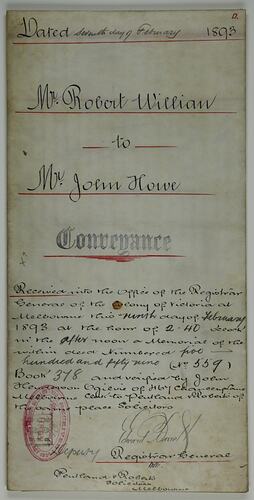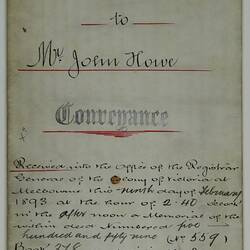Summary
Robert Willian (1862-1927) was a blacksmith whose story can be traced through a series of financial documents. Robert's story is that of his entire family which was affected by major events in Australia's history - the Depression of the 1890s, and World War I - and which contributed to early Australian Rules football and the building of Victoria, through migration, maritime technology, and the railways. It is also the story of a family (apparently) in perpetual debt.
Robert Henderson Mortimer Willian was born in 1862 at Fisherman's Bend, Victoria, to Anderson Hannibal Willian (hereafter 'Anderson') and Christina Henderson Willian (nee Kilgour). Robert's story is more than the sum of its parts. It is the story of his entire family which was affected by major events in Australia's history - the Depression of the 1890s, and World War I - and which contributed to early Australian Rules football and the building of Victoria, through migration, maritime technology, and the railways. It is also the story of a family (apparently) in perpetual debt.
Robert began his working life for the Hobson's Bay Railways in 1880 at the Yarra Bank workshops. As a 'Learner', Robert was not paid, but as he learned his trade as a blacksmith, his pay increased to 4/6 (4 shillings and 6 pence) by 1886. By 1886 Robert had married Eleanor Protheroe.
On July 20, 1886 Robert bought the Princes Street property from Mark Nelson, carpenter, of Williamstown, for £250. Willian then immediately used this property as collateral for a loan - a mortgage to E.G. Figg Esq, M.D. for just £240. Two years later, Dr. Figg reconveyed the Princes Street property to Willian, who, again, almost immediately, used the land as collateral for a loan, mortgaging the property to John Howe, gentleman, of Melbourne Road, Williamstown, for £270. In the same transaction, Robert lent a further £44 from Howe, effectively making the total amount owed £314.
For Robert, this meant that for 10 months after this mortgage was contracted, he would have been obliged to pay Howe £12 per month. At this time, Robert was working at the Newport, earning only earning 9/ (9 shillings) per day (pay rates in the documentary records probably indicate a daily, rather than weekly or monthly rate of pay), making a month of 30 days worked represent only a little over £13 pay. The family must have been under financial strain.
Unable to keep up the mortgage repayments, the property was conveyed to John Howe in 1893. Robert became insolvent a year after. In the 1890s the 'Great Crash' affected many. For the Willians', it meant a freeze in wages (Robert's wages remained the same from July 1890 to the May 1906) and a reduction in hours of work. The death of their daughter Beatrice would also have put emotional and financial pressure on the family.
Moving to the Ballarat/Ararat area after his insolvency, the family's financial troubles did not end. Robert owed his father £30 at the time of his death in 1908, which still needed to be paid, in monthly instalments of £1 for the benefit of his sister Annie.
As late as February 1919, a lawsuit is brought against Robert by William Bates, baker, for unpaid bills amounting to over £18. This is a complex case however the court eventually finds in favour of the Baker. As details of the case emerged, it became evident that the Willians' owed money to numerous creditors.
Robert Willian died at home in Ballarat on the 1st of July 1927.
References
Australian Electoral Commission, Australian Electoral Rolls.
Births, Deaths & Marriages Victoria.
Public Record Office of Victoria, Hobson's Bay Railway, Employee History Sheets, Rolling Stock Branch.
Public Record Office of Victoria, Wills.
The Ararat Advertiser.
More Information
-
Keywords
Working Life, Cultures and histories : Melbourne and Victoria
-
Authors
-
Article types




